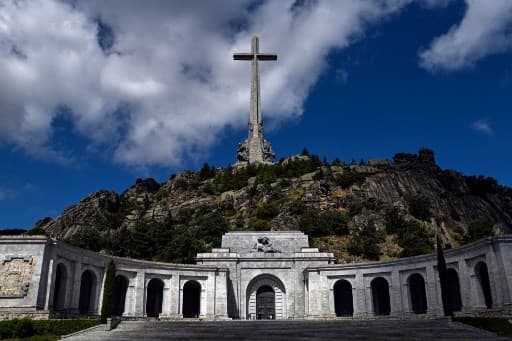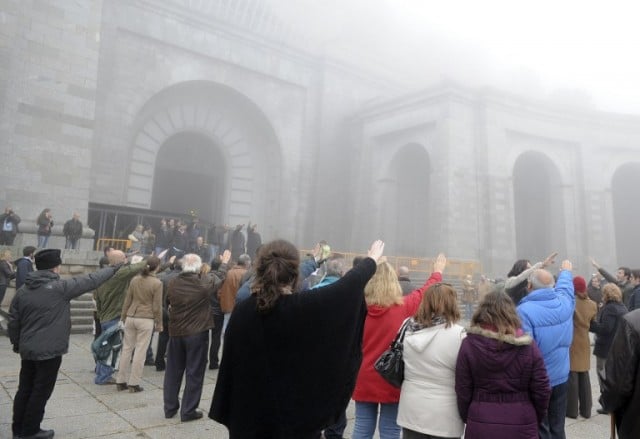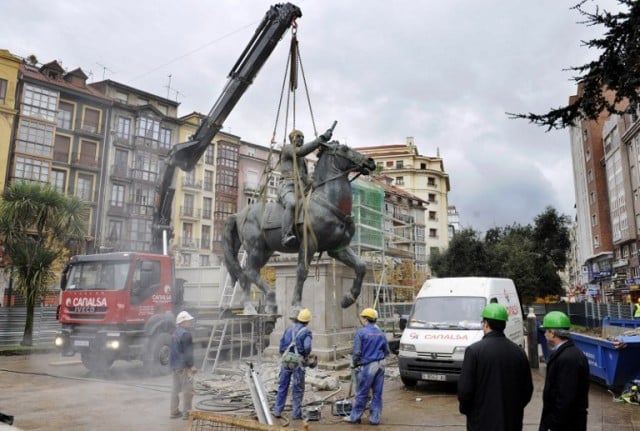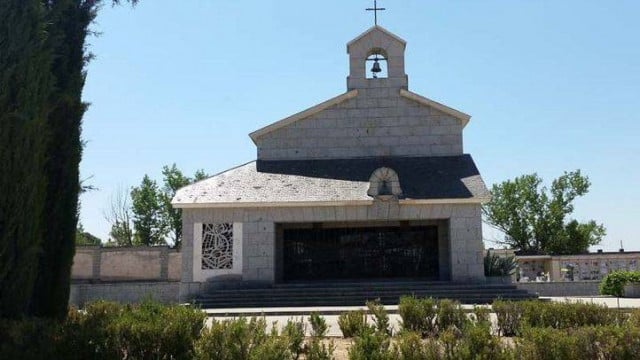EXPLAINED: Why Spain is on the verge of digging up General Franco

Spain's Supreme Court on Tuesday gave the green light for the government to remove the remains of Francisco Franco from a grandiose state mausoleum, rejecting an appeal against it by the late dictator's descendants.
In a unanimous ruling, the court decided "to completely reject the appeal lodged by the family in relation to Francisco Franco's exhumation," the judges wrote.
The issue has divided opinion in Spain, which is still conflicted over the dictatorship that ended with Franco's death in 1975.
Prime Minister Pedro Sanchez's Socialist government has made transferring Franco's remains a priority, arguing the country could not "continue to glorify" the dictator, who is interred at a huge hillside mausoleum belonging to the Catholic Church in the Valley of the Fallen, west of Madrid.
On Tuesday he hailed the Supreme Court ruling as "a great victory for Spanish democracy".
In a message he wrote on Twitter he said his government was determined "to redress the suffering of victims of Francoism".
Hoy vivimos una gran victoria de la democracia española. La determinación de reparar el sufrimiento de las víctimas del franquismo guio siempre la acción del Gobierno. El Supremo avala la exhumación de los restos de Franco y su traslado a El Pardo.
Justicia, memoria y dignidad.
— Pedro Sánchez (@sanchezcastejon) September 24, 2019
The imposing basilica has drawn the attention of both tourists and right-wing sympathisers who have rallied at the site.
Officials had planned to move Franco's remains to a more discreet family tomb on June 10th.
But six days beforehand, the court suspended the exhumation pending the outcome of an appeal by Franco's heirs.
Six magistrates from the country's top court are due to meet at 10:00 am on Tuesday to deliver their ruling.
Regardless of the ruling, the court still has to consider three other appeals, although a court spokesman said it was "foreseeable" that the magistrates would rule along the same lines.
"We hope that justice will be done," said Spain's Deputy Prime Minister Carmen Calvo on Monday, criticising the "indignity of always having the dictator in a glorified place."
So why is Spain still talking about the corpse of the dictator who died over 40 years ago?
The Local takes a look at the issue:
What exactly is the Valley of the Fallen?
 The basillica was hewn out of the living rock by Republican prisoners. Photo: AFP
The basillica was hewn out of the living rock by Republican prisoners. Photo: AFP
It is a huge basilica carved out of the living rock on a hillside 50km (30 miles) northwest of Madrid. The complex in the Guadarama hills is spread out over 13.6 square kilometres and is surrounded by pine forests. It includes a colossal esplanade leading to the colonnades and the entrance to the basilica.
It’s eerie interior is reached through airport-style security gates past a “museum shop” into a vast vaulted and domed space with black marble floors and walls lined with faded apocalyptic tapestries. Helmeted militaristic statues keep a watchful eye over worshippers and sword-bearing angels stand sentry to chapels dedicated to the armed forces.
The complex also includes a Benedictine abbey and the monks are still responsible for maintaining the site. Mass is held on Sundays.
A giant granite cross, reaching a height of 150 meters (500 ft) crowns the complex and is visible for miles on a clear day from vantage points in the capital.
Who is buried there?
.jpg)
Franco's tomb is always laid with fresh flowers. Photo: AFP
In the centre of the basilica either side of the altar and beneath a gold mosaic dome illustrated with scenes from the Bible are two tombs; that of General Francisco Franco and Jose Antonio Primo de Rivera, the founder of the fascist Spanish Falange party.
Freshly cut flowers are always to be found laid atop each tombstone.
Crypts on either side contain the remains of an estimated 50,000 people who were killed in the Spanish Civil War, including those of Republican supporters whose corpses were dug up after the conflict and added in order to fill the huge crypt.
Who built it?
On April 1st, 1940, a year after the end of the Civil War, General Franco announced plans for the Valle de los Caidos (Valley of the Fallen), a project to establish “a place of rest and meditation to perpetuate the memory of those who fell in our glorious Crusade.”
Pedro Muguriza, one of the leading Spanish architects of the time was charged with the design, and he enlisted Diego Méndez to assist.
Republican prisoners were drafted in to dig the site out of the granite mountainside where they lived in work camp conditions on site. Many died during construction before it was finally completed in 1958. Estimates range from 15 (according to regime officials) to 27,000.
Who goes there?

Supporters gather at the Valley of the Fallen in 2012 to honour Franco with the fascist salute on the anniversary of his death. Photo: AFP
Each year on November 20th the Francisco Franco Foundation has organized a mass to commemorate the anniversary of the death of dictator in 1975. The site has served as a rallying point for supporters of Franco and neo-fascist groups, although such displays are now outlawed under the Historical Memory Law (of which more later).
Apart from die-hard fascists and those wishing to pay their respects to the late Generalissimo, the site is also popular with tour groups with coach loads arriving each day after visiting the nearby San Lorenzo de El Escorial.
The site attracts around 240,000 visitors each year, making it one of the top tourist attractions in the Madrid region and the fourth most visited site managed by Spain’s National Heritage Trust.
Many of those whose relatives died fighting Francoist forces swear never to set foot there.
Why the controversy?
Well, aside from the fact that it was built by the slave labour of those who opposed the regime and contains the unidentified remains of tens of thousands of those killed by Francoist forces during the Civil War, now lying jumbled up alongside the remains of those they opposed, such a memorial is arguably against the law.
The Historical Memory Law, introduced in 2007 under the socialist government of Jose Luis Rodriguez Zapatero in an attempt to heal the wounds of the past, banned public symbols that honoured the dictator and his supporters.

This statue of Franco was removed from the city of Santander in 2008. Photo: AFP
While street names have been changed and statues of Franco removed from public squares, the most symbolic memorial of the era has remained untouched.
READ MORE: Madrid banishes ghost of Franco from its streets with name changes.
But victims' associations say the continued existence of the memorial is "an insult to modern democratic Spain”. At the very least, Franco should be dug up and removed from the site, they say.
Some have called for the entire site to be blown up while others insist it would be enough if it was transformed into a centre for reconciliation that provided an accurate account of its history.
"We believe that the State is subjecting the dictatorship's victims to a form of mistreatment and humiliation by obligating them to pay through their taxes for dictator Francisco Franco's tomb, which is sustained through public funds," the Association for the Recovery of Historical Memory (ARMH) has told The Local.
Who wants to keep him there?
Descendants of the former ruler have expressed determination to ensure Franco stays at the Valley of the Fallen.
"When you attack Franco, you attack my family, over half of Spain, the monarchy and the Church which protected him," Franco's great-grandson Luis Alfonso de Borbon said in an interview published in conservative daily newspaper La Razon in October.
"We will continue our legal battle to the end so Franco stays there," said Juan Chicharro Ortega, spokesman for the Francisco Franco Foundation, which defends the memory of the dictator and has filed one of the remaining three appeals
.What next?
If the exhumation could not be stopped, Franco's heirs had wanted his remains to be moved to the Almudena Cathedral in Madrid, where his daughter is buried.
In a report prepared last November, the government said it fears such a central site as the Almudena, would only attract an even larger number of visitors. This would pose a significant headache for security forces as it is right next door the Royal Palace.
The government successfully lobbied the Vatican to reject this optionInstead the government has suggested that a grave in the Mingorubbio cemetery in El Pardo, a town on the edge of Madrid where the Franco family had a palace, would be ideal.
His wife, Carmen Polo was buried there on her death in 1988.

The Mingorubbia cemetery in El Pardo has been suggested for reburial.
But there are still fears that any new burial site will become a place of pilgrimage for admirers of Franco and supporters of fascism.
Tuesday's hearing was one of four appeals against the plan, but arguably the one that carries the most weight, with a court spokesman saying it was "foreseeable" that the judges would issue a similar verdict in the remaining three cases.
It was not immediately clear when the court would rule on the other three
appeals.
Since the Socialists returned to power last year, they have made the exhumation a priority, but with another election due in November, can Pedro Sanchez fulfil his pledge before Spain returns to the polls?
READ MORE:
Comments
See Also
In a unanimous ruling, the court decided "to completely reject the appeal lodged by the family in relation to Francisco Franco's exhumation," the judges wrote.
The issue has divided opinion in Spain, which is still conflicted over the dictatorship that ended with Franco's death in 1975.
Prime Minister Pedro Sanchez's Socialist government has made transferring Franco's remains a priority, arguing the country could not "continue to glorify" the dictator, who is interred at a huge hillside mausoleum belonging to the Catholic Church in the Valley of the Fallen, west of Madrid.
On Tuesday he hailed the Supreme Court ruling as "a great victory for Spanish democracy".
In a message he wrote on Twitter he said his government was determined "to redress the suffering of victims of Francoism".
Hoy vivimos una gran victoria de la democracia española. La determinación de reparar el sufrimiento de las víctimas del franquismo guio siempre la acción del Gobierno. El Supremo avala la exhumación de los restos de Franco y su traslado a El Pardo.
— Pedro Sánchez (@sanchezcastejon) September 24, 2019
Justicia, memoria y dignidad.
The imposing basilica has drawn the attention of both tourists and right-wing sympathisers who have rallied at the site.
Officials had planned to move Franco's remains to a more discreet family tomb on June 10th.
But six days beforehand, the court suspended the exhumation pending the outcome of an appeal by Franco's heirs.
Six magistrates from the country's top court are due to meet at 10:00 am on Tuesday to deliver their ruling.
Regardless of the ruling, the court still has to consider three other appeals, although a court spokesman said it was "foreseeable" that the magistrates would rule along the same lines.
"We hope that justice will be done," said Spain's Deputy Prime Minister Carmen Calvo on Monday, criticising the "indignity of always having the dictator in a glorified place."
So why is Spain still talking about the corpse of the dictator who died over 40 years ago?
The Local takes a look at the issue:
What exactly is the Valley of the Fallen?
 The basillica was hewn out of the living rock by Republican prisoners. Photo: AFP
The basillica was hewn out of the living rock by Republican prisoners. Photo: AFP
It is a huge basilica carved out of the living rock on a hillside 50km (30 miles) northwest of Madrid. The complex in the Guadarama hills is spread out over 13.6 square kilometres and is surrounded by pine forests. It includes a colossal esplanade leading to the colonnades and the entrance to the basilica.
It’s eerie interior is reached through airport-style security gates past a “museum shop” into a vast vaulted and domed space with black marble floors and walls lined with faded apocalyptic tapestries. Helmeted militaristic statues keep a watchful eye over worshippers and sword-bearing angels stand sentry to chapels dedicated to the armed forces.
The complex also includes a Benedictine abbey and the monks are still responsible for maintaining the site. Mass is held on Sundays.
A giant granite cross, reaching a height of 150 meters (500 ft) crowns the complex and is visible for miles on a clear day from vantage points in the capital.
Who is buried there?
.jpg)
Franco's tomb is always laid with fresh flowers. Photo: AFP
In the centre of the basilica either side of the altar and beneath a gold mosaic dome illustrated with scenes from the Bible are two tombs; that of General Francisco Franco and Jose Antonio Primo de Rivera, the founder of the fascist Spanish Falange party.
Freshly cut flowers are always to be found laid atop each tombstone.
Crypts on either side contain the remains of an estimated 50,000 people who were killed in the Spanish Civil War, including those of Republican supporters whose corpses were dug up after the conflict and added in order to fill the huge crypt.
Who built it?
On April 1st, 1940, a year after the end of the Civil War, General Franco announced plans for the Valle de los Caidos (Valley of the Fallen), a project to establish “a place of rest and meditation to perpetuate the memory of those who fell in our glorious Crusade.”
Pedro Muguriza, one of the leading Spanish architects of the time was charged with the design, and he enlisted Diego Méndez to assist.
Republican prisoners were drafted in to dig the site out of the granite mountainside where they lived in work camp conditions on site. Many died during construction before it was finally completed in 1958. Estimates range from 15 (according to regime officials) to 27,000.
Who goes there?

Supporters gather at the Valley of the Fallen in 2012 to honour Franco with the fascist salute on the anniversary of his death. Photo: AFP
Each year on November 20th the Francisco Franco Foundation has organized a mass to commemorate the anniversary of the death of dictator in 1975. The site has served as a rallying point for supporters of Franco and neo-fascist groups, although such displays are now outlawed under the Historical Memory Law (of which more later).
Apart from die-hard fascists and those wishing to pay their respects to the late Generalissimo, the site is also popular with tour groups with coach loads arriving each day after visiting the nearby San Lorenzo de El Escorial.
The site attracts around 240,000 visitors each year, making it one of the top tourist attractions in the Madrid region and the fourth most visited site managed by Spain’s National Heritage Trust.
Many of those whose relatives died fighting Francoist forces swear never to set foot there.
Why the controversy?
Well, aside from the fact that it was built by the slave labour of those who opposed the regime and contains the unidentified remains of tens of thousands of those killed by Francoist forces during the Civil War, now lying jumbled up alongside the remains of those they opposed, such a memorial is arguably against the law.
The Historical Memory Law, introduced in 2007 under the socialist government of Jose Luis Rodriguez Zapatero in an attempt to heal the wounds of the past, banned public symbols that honoured the dictator and his supporters.

This statue of Franco was removed from the city of Santander in 2008. Photo: AFP
While street names have been changed and statues of Franco removed from public squares, the most symbolic memorial of the era has remained untouched.
READ MORE: Madrid banishes ghost of Franco from its streets with name changes.
But victims' associations say the continued existence of the memorial is "an insult to modern democratic Spain”. At the very least, Franco should be dug up and removed from the site, they say.
Some have called for the entire site to be blown up while others insist it would be enough if it was transformed into a centre for reconciliation that provided an accurate account of its history.
"We believe that the State is subjecting the dictatorship's victims to a form of mistreatment and humiliation by obligating them to pay through their taxes for dictator Francisco Franco's tomb, which is sustained through public funds," the Association for the Recovery of Historical Memory (ARMH) has told The Local.
Who wants to keep him there?
Descendants of the former ruler have expressed determination to ensure Franco stays at the Valley of the Fallen.
"When you attack Franco, you attack my family, over half of Spain, the monarchy and the Church which protected him," Franco's great-grandson Luis Alfonso de Borbon said in an interview published in conservative daily newspaper La Razon in October.
"We will continue our legal battle to the end so Franco stays there," said Juan Chicharro Ortega, spokesman for the Francisco Franco Foundation, which defends the memory of the dictator and has filed one of the remaining three appeals
.What next?
If the exhumation could not be stopped, Franco's heirs had wanted his remains to be moved to the Almudena Cathedral in Madrid, where his daughter is buried.
In a report prepared last November, the government said it fears such a central site as the Almudena, would only attract an even larger number of visitors. This would pose a significant headache for security forces as it is right next door the Royal Palace.
The government successfully lobbied the Vatican to reject this optionInstead the government has suggested that a grave in the Mingorubbio cemetery in El Pardo, a town on the edge of Madrid where the Franco family had a palace, would be ideal.
His wife, Carmen Polo was buried there on her death in 1988.

The Mingorubbia cemetery in El Pardo has been suggested for reburial.
But there are still fears that any new burial site will become a place of pilgrimage for admirers of Franco and supporters of fascism.
Tuesday's hearing was one of four appeals against the plan, but arguably the one that carries the most weight, with a court spokesman saying it was "foreseeable" that the judges would issue a similar verdict in the remaining three cases.
It was not immediately clear when the court would rule on the other three
appeals.
Since the Socialists returned to power last year, they have made the exhumation a priority, but with another election due in November, can Pedro Sanchez fulfil his pledge before Spain returns to the polls?
READ MORE:
Join the conversation in our comments section below. Share your own views and experience and if you have a question or suggestion for our journalists then email us at [email protected].
Please keep comments civil, constructive and on topic – and make sure to read our terms of use before getting involved.
Please log in here to leave a comment.